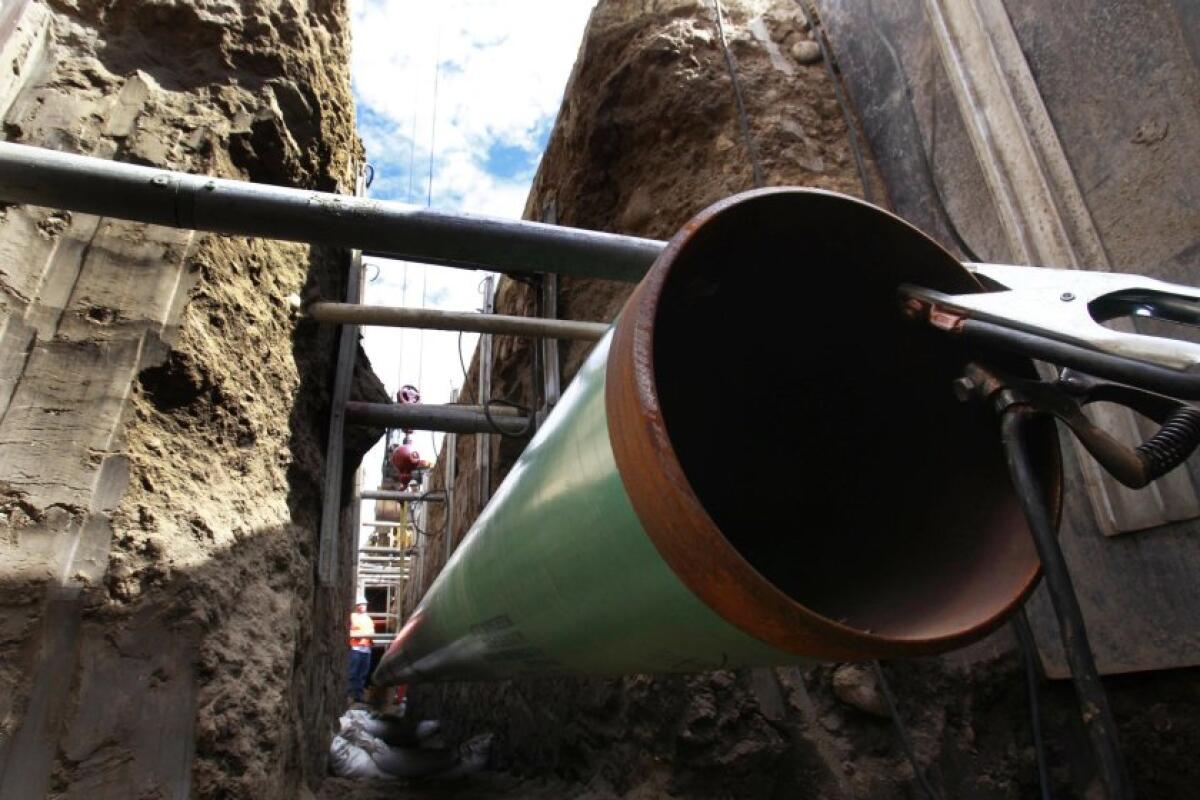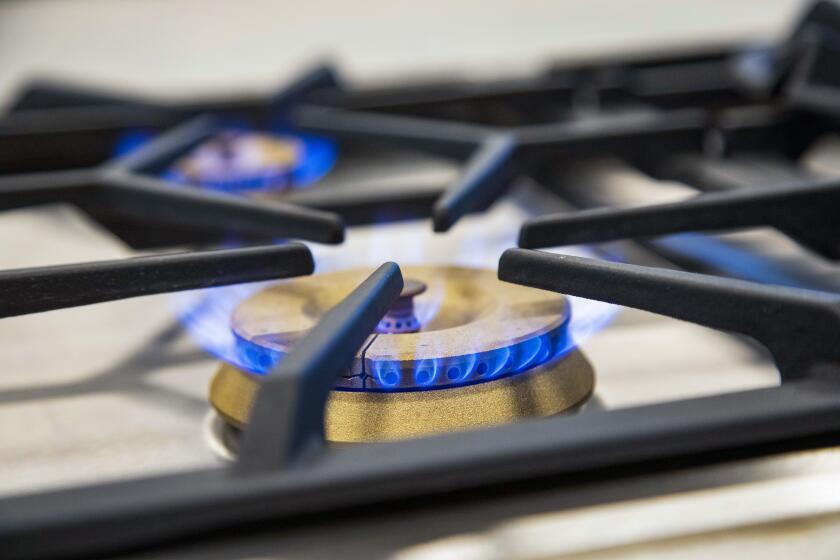Why natural gas prices — and bills — are soaring in Southern California

Southern California Gas Co. and San Diego Gas & Electric have issued stark warnings to customers that their January natural gas bills could double, citing factors for historically high wholesale costs that include sinking inventories, supply constraints and a cold start to winter that has soaked the West Coast.
But in many other parts of the country, natural gas futures prices have plunged, with traders Friday seeing a 17-month low at Henry Hub, a Louisiana natural gas pipeline that serves as the benchmark for the North American natural gas market on the New York Mercantile Exchange.
“It’s the exact opposite of what’s happening in California today,” said Robert Yawger, managing director and energy futures strategist based in New Jersey at investment firm Mizuho Securities.
But Yawger said he was not surprised at such a marked contrast.
“It’s a big country and there are regional differentials that will spike — or slide for that matter — and right now, because of the weather situation in California, you’re getting some big spikes,” he said.
Since Christmas, portions of the East and Midwest have enjoyed almost balmy conditions, and the weather outlook calls for above-average temperatures for most of January. That’s led to a big drop in natural gas use, higher than normal storage levels for much of the nation and falling futures prices at exchanges such as the NYMEX.
It’s a much different story in California, Yawger said, where wet weather and colder-than-normal temperatures have increased consumption of natural gas, which provides heating and powers gas stoves for SoCalGas’ 5.9 million customers and SDG&E’s 873,000 customers who have gas meters in their service territories.
The U.S. Energy Information Administration also cited constraints in gas deliveries heading to California from places including west Texas, inventories on the West Coast that are well below the five-year average and reduced pipeline capacity for the unprecedented price spike. Wholesale natural gas prices also have increased in Northern California, Oregon and Washington, the Energy Information Administration said.
Southern California “sits at the end of the pipe,” said Jeff Richter, principal owner of Energy GPS, an Oregon-based energy analytics company.
The Pacific Northwest exports hydroelectric power to the Golden State but cold and dry weather in November and December resulted in Oregon and Washington sending fewer megawatts of power to California. That left California more reliant on power plants fueled by natural gas.
“Dry and cold means you don’t have the hydro that you had last year and cold means you had higher demand and the Northwest kept everything — every megawatt — at home and didn’t send it down” to California, Richter said.
A SoCalGas household’s monthly bill of $65 from last January probably will reach about $160 this January, the utility said, and a $130 bill will be more like $315. An SDG&E household gas bill that came to about $105 last January is now estimated to leap to about $225 this month.
Both utilities are units of San Diego energy giant Sempra Energy, and SoCalGas buys natural gas supplies for itself and its sister subsidiary primarily from Colorado, Wyoming, New Mexico, west Texas and parts of Canada under contracts that go out as long as one year. The contracts are purchased at an index price that is set each month and can fluctuate, given market conditions.
With the cost of natural gas skyrocketing, utility bills in Southern California are going to jump. To help manage the costs, SoCalGas offers several programs.
The price for what’s called “core procurement” that goes to residential and small commercial customers is set at the start of each month. The price soared from to $3.45 per therm (a unit of natural gas) on Jan. 1 from $1.05 in December. In January 2022, it was 84 cents.
A new price will be posted Feb. 1. SoCalGas and SDG&E representatives are reluctant to guess whether the price will drop next month, especially with forecasts indicating that cold and wet weather will linger for about two more weeks.
“The high bills are a result of historically high natural gas prices, specifically in the western United States,” SoCalGas spokesperson Chris Gilbride said in an email.
But some aren’t buying that explanation.
A factor in the rising cost of natural gas is increased exports of liquefied natural gas to countries in Europe to take advantage of the higher prices those countries have been willing to pay, said Jamie Court, president of Los Angeles-based Consumer Watchdog. The European Union is reliant on Russian natural gas and has been stockpiling supplies since Russia invaded Ukraine in February.
Sempra has invested heavily to become a big player in the global LNG export market. It owns a majority share of Cameron LNG, a $10.5-billion facility on the Louisiana Gulf Coast, is constructing an export component to an already existing LNG terminal near Ensenada, and has plans to build a large LNG facility in Port Arthur, Texas.
The American Gas Assn., a trade organization for gas companies, says the U.S. “has more than enough natural gas to satisfy the current level of exports and more while keeping prices affordable and stable for natural gas customers.”
SDG&E and SoCalGas insist the companies are not profiting from the January price spike.
“Neither SoCalGas nor SDG&E sets the price for natural gas,” Gilbride said. “Instead, natural gas prices are determined by national and regional markets. SoCalGas buys natural gas in those markets on behalf of residential and small business customers, and the cost of buying that gas is billed to those customers with no markup, meaning SoCalGas and SDG&E do not profit from gas commodity prices going up.”
According to California law, investor-owned utilities cannot make money when customers use more gas or electricity. Since 1982, sales are “decoupled” from profits and the cost of natural gas and electricity is a pass-through to customers’ bills.
“There’s no way that a utility in this day and age is going to go out of their way and risk their reputation, and basically the value of their company through their stock valuations, by manipulating the market,” Yawger of Mizuho said.
As for high prices, Richter says an additional factor relates to a record-breaking “heat dome” in the Pacific Northwest in June 2021 that saw temperatures soar to more than 110 degrees.
Home cooling was not common in coastal areas of Oregon and Washington but after the heat wave, many residents installed air conditioning. That, Richter believes, has led to a surge in electricity usage.
“They’re turning it on now when it’s 75 degrees, I don’t care what anybody says,” Richter said. “Now with that increased demand in the Northwest and below normal hydro” output, the region “can’t, in theory, give as much to California as it used to, and California needs to be planning for that.”
Nikolewski writes for the San Diego Union-Tribune. Los Angeles Times writer Russ Mitchell contributed to this report.
More to Read
Inside the business of entertainment
The Wide Shot brings you news, analysis and insights on everything from streaming wars to production — and what it all means for the future.
You may occasionally receive promotional content from the Los Angeles Times.












